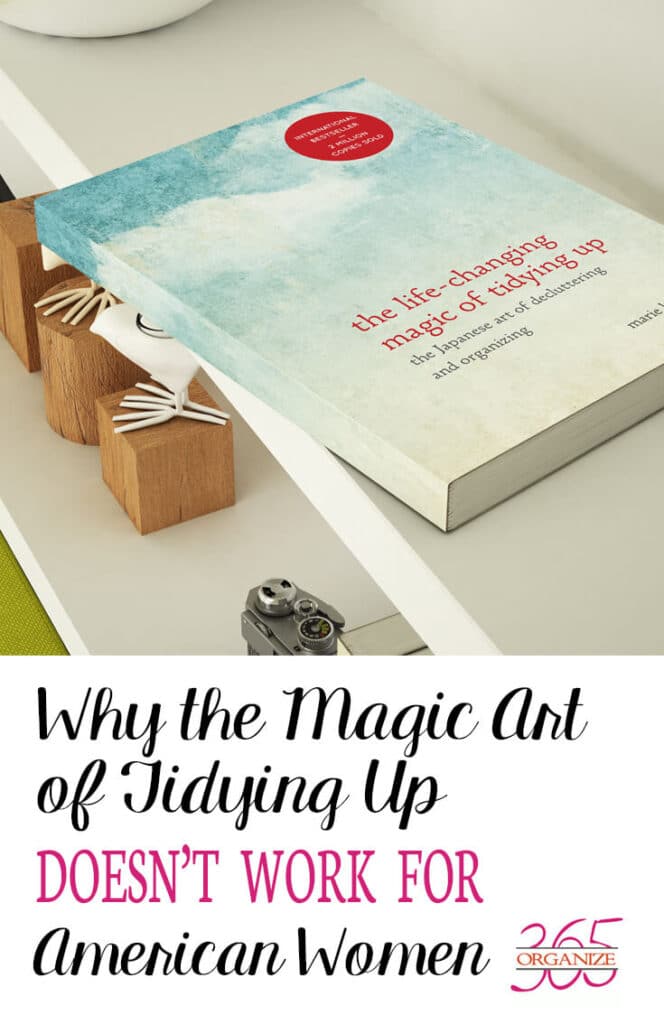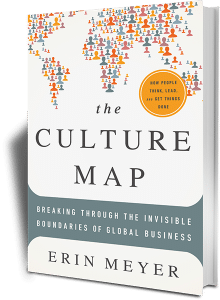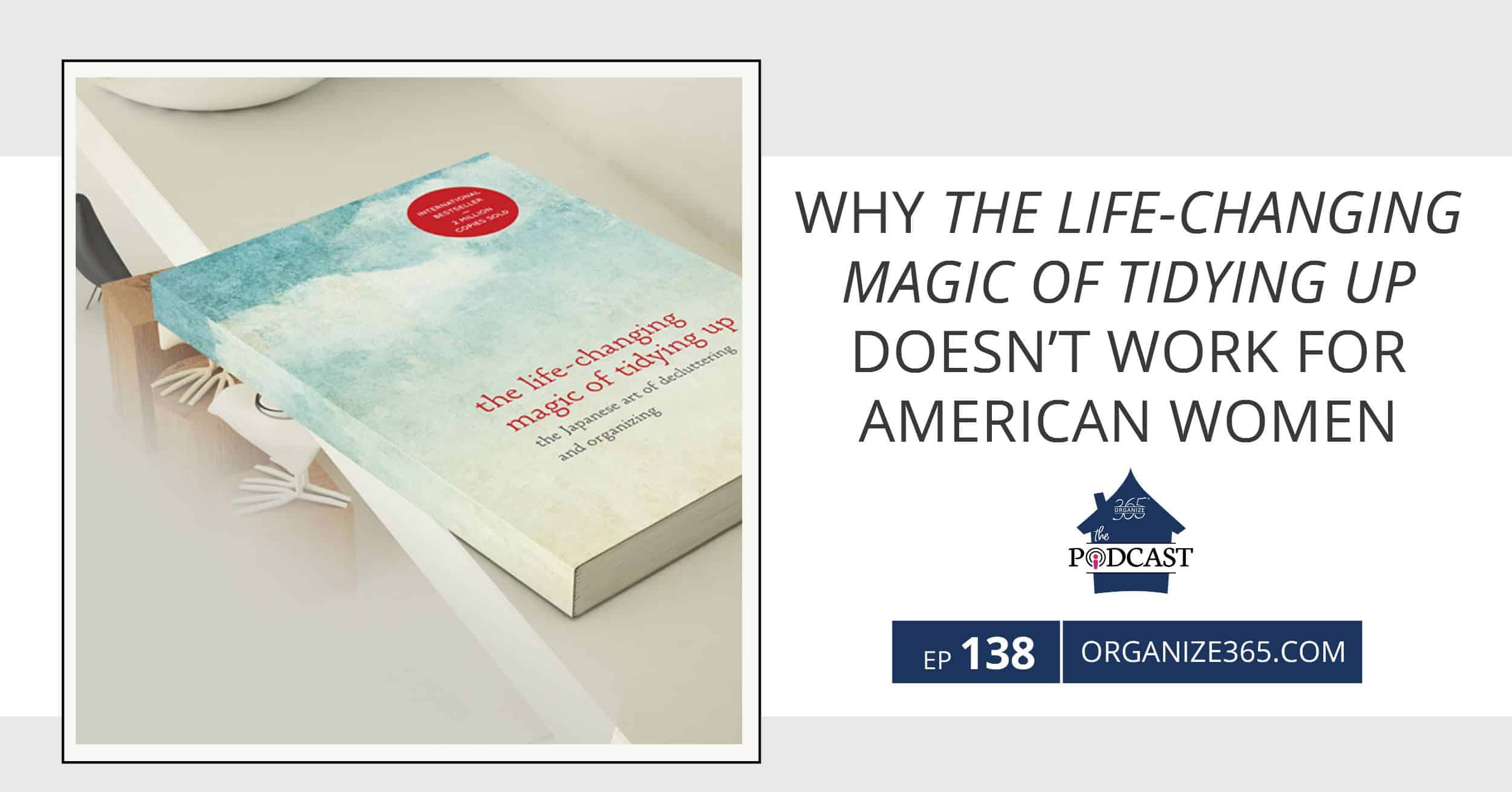
Why The Magic Art of Tidying Up Doesn’t Work For American Women
Today on the podcast, I am reviewing the book The Life-Changing Magic of Tidying Up by Marie Kondo. I’m sharing what I like, don’t like, and why I think that this book doesn’t work for American women.
Talk about a controversial statement, I know, but I think The Life-Changing Magic of Tidying Up does not work for the majority of American women. Marie and I approach organizing differently based on our ages and countries of origin.
Let’s start with our ages. When Marie wrote the book The Life-Changing Magic of Tidying Up, she was a millennial woman without children living in Japan with a minimalist mindset.
I have defined the 4 phases of life that a woman goes through as Childhood (7-21), Accumulation (21-40), Survival (40-55), and Downsizing & Legacy (55+). Marie has been through the phase of childhood and she is moving through the phase of accumulation.
I am an almost 45-year-old middle-class American woman. I am a member of Generation X with two teenage kids who are 15 and 16. I am an organized person, but not a minimalist. Everything in my home has a place and I focus on function over beauty. I call myself a functional organizer. I have been through the phases of childhood, and accumulation, and I am firmly in the survival phase of my life.
Let’s start with what I absolutely love about Marie’s book.
#1 I love that she has brought the discussion of clutter and organizing to the attention of the media and people around the world.
Six million books is a lot of books sold! Marie has been in major media, and she has been quoted in so many news outlets that when I did my research about the amount of clutter in Japanese homes, I couldn’t find anything that did not lead to an article about Marie Kondo or her website.
#2 I like the idea behind her method of sparking joy. “If it doesn’t spark joy, then you should get rid of it.”
This method works particularly well for clothing. I get email after email after email from people who find Organize 365 after they’ve bought Marie’s book and it has worked wonders in their closet. There’s something about reading The Life-Changing Magic of Tidying Up and the idea of items “sparking joy” that resonates particularly well in a woman’s closet.
This also works well for Americans because most of the concrete examples that Marie uses in her book involve clothing. When I get to the cultural differences in a minute, you’ll see how as Americans, we need to know exactly what to do with each kind of clutter that we have. Since almost all of Marie’s examples relate to clothing, it is easy for Americans to extrapolate that message to their clothing and implement her ideas. However, the message of “sparking joy” doesn’t easily translate over to some other areas of clutter in American homes.
For Americans, when you get down to memorabilia and some of the items that Marie doesn’t touch on, or doesn’t feel are as important, sparking joy has a whole new connotation. Americans love every drawing that their child ever drew, and we love everything that our mom who has passed away left in her house. The qualifier “if it sparks joy or doesn’t spark joy” isn’t a good indicator of how to declutter these areas.
#3 I also love that Marie champions the idea that organization is a teachable and learnable skill.
Yes, yes, YES! That is what I have been saying for years, it doesn’t matter if you’re not organized now, you can learn to be organized.
Before we go any further, let’s get a good picture of the difference between an American house and a Japanese house.
A comparison of Japanese and American homes.
In Japan, the majority of people live in apartments and some live in what are considered slightly larger houses. Japan as a country is an island, about the size of California, and 87% of the country is covered in mountains. So there isn’t a lot of land left to build houses for the tenth largest country by population.
The size difference between living in an apartment and living in a stand-alone house is very small. The average size of a Japanese apartment is 1000 square feet and has four rooms. The average size of a Japanese stand-alone house is 1300 square feet and has five rooms.
Japanese homes are highly functional and their rooms have multiple uses. In America, we might have a living room, a dining room, a kitchen, and a home office. In Japan, they would have a kitchen and a multipurpose room that would function as their living room, their dining room, and their home office, all in one. They don’t have the luxury of having piles of stuff everywhere because that room has to function for multiple uses. It is very rare for a Japanese home to have a basement or garage.
The average American house is 2400 square feet. However, that does not count the basement and garage space most American homes have as well. For many Americans who do not live in the city, that 2400 square foot house can easily have over 3000+ square feet of living and storage space. Additionally, 10% of all Americans rent storage space for items that do not fit in their homes.
When comparing a Japanese house to an American house, you’re comparing 3000+ square feet of storage space to the average 1000 to 1300 square feet of storage space in a Japanese home.
Marie has done all of her organizing in Japan so she has not met the American woman that is me who has 3000+ square feet worth of space and fills every nook and cranny with all that I think is special and pretty and that I want to have. Now, let’s compare some of the spaces inside that house.
In my 2400 square foot home, I have 8 rooms and 3 bathrooms with 4 more rooms and another bathroom in the basement. Japanese houses have four to five rooms.
American kitchens include a cooking area, some kind of island or peninsula, and a kitchen table. Most American homes have a pretty big area devoted to their kitchen. The majority of Japanese homes do not have an oven or dishwasher. They cook on a stove and have very few counters.
90% of the Japanese population lives in urban areas. Most Japanese homes do not have yards, and if they do have yards, they’re very small. My yard takes a lot of my time, money, and equipment to maintain. Additionally, Americans tend to spend a lot of time in their homes, whereas the Japanese, as a culture, do not spend very much time at home.
And then finally, I thought this was very interesting, in Japan 60% of the men and 80% of the women who are between the ages of 20 to 34 (which is what I call the accumulation phase) still live at home with their parents. In Japan, until you get married, you don’t move out of your parent’s house. A lot of that playing house and setting up your first apartment that we do in America comes with buying all the things that you would put in that apartment or that house. So if you aren’t in a new apartment or a new house in your 20s and early 30s, then you don’t have to accumulate all of that stuff either.
In summary, Americans have three to four times the space that the Japanese do in their dwellings. Which leads to a lot more items that need to be decluttered and organized.
Next, let’s explore the differences between American and Japanese culture and a few other cultures that I have personally visited.
The differences between Japanese and American culture.
This past summer, I attended The Global Leadership Summit. Erin Meyer of ErinMeyer.com was one of the featured speakers. She talked about the difference between how different cultures interact and communicate and how that impacts work environments.
Erin talked a lot about the difference between American and Japanese culture as it relates to how directly or indirectly we communicate. I remember listening to her story and thinking, “Oh, that’s why Marie’s book doesn’t make as much sense for Americans as it does for Japanese.” Let me share Erin’s story and see what you think.
Erin explained that she had gone to Japan and had just finished giving a presentation. When she was done speaking, she asked the Japanese audience if they had any questions. After a minute or two, no one raised their hand so she sat down.
The person who had hired her for the presentation asked, “Do you mind if I ask the audience if they have any questions?” And she said, “No, go ahead.”
He stood up and looked at the audience and said, “Erin did a great presentation today, does anyone here have any questions?”
Then he slowly looked at each person in the audience. After a few seconds had passed, he stopped at one person, he said, “Yes, you have a question.” They said, “Yes, thank you very much.” They then asked their question and Erin answered.
Then he surveyed the audience again. Again, no one was raising their hand. He looked at another person and said, “Yes, you have a question.” They said, “Yes, thank you very much” and they asked their question.
After the event, Erin asked him, “How did you know that they had questions to ask? No one ever raised their hand?” And he said, “Well, their eyes were bright.”
In Japan, people do not make eye contact like Americans do. When Erin was done speaking, the man stood up and surveyed the audience, and anyone who did not have a question was not making eye contact with him. But anyone who wanted to ask a question was looking intently at him with what he called “bright eyes.” Then he would ask them, “Do you have a question?” And they would say, “Of course, yes, thank you.”
The next day, Erin was speaking to a different group in Japan and, when she was done speaking, she asked if there were any questions. Again, nobody raised their hands. She thought, “Well, maybe I should look and see if there are any bright eyes.” She looked out into the audience and surveyed each person and sure enough, she would come across people who were in direct eye-to-eye contact with her. Then she asked, “Do you have a question?” And they would say, “Yes, thank you for asking.”
The idea of cultural differences in communication fascinates me. If you would like to explore Erin’s research more, I think you would like her book, Culture Map.
I noticed a few references in Marie’s book about people having bright eyes. This is part of Japanese culture. The Japanese have an intuitive ability to feel. They can read the energy in the air. This is not something Americans can do, especially me! I’m as American as you can be as far as that is concerned. You literally have to hit me over the head with a frying pan to tell me something that is not very obvious.
Erin explains that Americans need explicit directions. In American presentations, you say what you’re going to say, you say it, and then you review what you just said. That is very American.
The Japanese are the most intuitive of all cultures. We are 100% oppositional on this. So when we try to connect on things like decluttering the house, Marie can go in the house and say, “Does that spark joy?” and that’s all she has to say. She probably doesn’t even have to say it. She probably just has to stand there and the person next to her says, “This doesn’t spark joy” or they just get rid of it. There is no need for explicit explanations of what sparking joy means or how it feels. It just is.
Here in America, it’s our stuff and we like our stuff. It all sparked joy at one point, that’s why it’s in the house. So why would we want to get rid of it now? Maybe it will spark joy later, we don’t know. This whole sparking joy idea is really hard for us to understand. We can understand it easiest with our clothing because 1) our clothing only affects us, it doesn’t affect anyone else in our family, and 2) Marie gave the most explicit instructions on how to see if your clothing sparks joy in her book.
Americans love to have rules. When I was a scrapbooking consultant, I used to say, “You can have 200 pictures in an album.” Then people would organize their pictures. Before the rule, my clients would shuffle pictures from box to box without making much progress. But once I said, “You can have 200 pictures in a book,” they would divide out the pictures into stacks of 200. We love to have rules, we love to be told what to do. And as soon as we’re told what to do, it doesn’t matter who says it, we’ll act on that because we have a plan.
This is why The Productive Home Solution that I have worked so well in getting your home organized. It was designed with a short 2-3 minute video and a 15-minute actionable task to do each day.
Now I don’t say that you’ll be all the way organized in one fell swoop as Marie does. Remember, we have three to four times as much stuff as the Japanese have. And I always say it takes going through your house three times before you will get completely organized.
Here are a couple of other cultural things that I’ve noticed from my worldly travels.
About 30 years ago, I went to seven countries in Europe as part of a high school exchange program. It was amazing. And in three of those countries, I lived in people’s houses for about five days at a time. I stayed in an apartment in Barcelona, Spain, a farmhouse in the south of France, and a home in Austria.
The first thing that I noticed when I was in Europe in the 80s was how small everything was. All the houses were smaller, the cars were smaller, the roads were smaller, and everything was so old. I was usually in cities, but even on the countryside farm in France, the house only had three rooms. I stayed in a stone cellar room on the ground level. The family’s home was upstairs. The places I went had nice things, but they did not have very many things, even compared to what I had in the 80s in my home.
About 25 years ago when I was in college, I went to China as part of an ambassador exchange program to look at their kindergartens. The children at the kindergartens I visited would go to school six days a week. They would show up for school Monday morning and they would stay there until Saturday night. They had a class at the bottom of the school house and the upstairs of the kindergarten held dorm rooms of beds and a communal bathroom.
I thought it was just this one kindergarten that we saw in Beijing that was an upscale kindergarten for the elite. However, after talking with an exchange student from China, I realized that many Chinese children live at school at younger ages than American students do. In his province in China, all the students live at high school 6 days a week.
Every country and culture has its way of raising its children, educating their children, how they live, where they live, what they eat, and how they prepare food. As I was researching this article, I started thinking about how my challenges are based on the American school year. I thought, “Well, Lisa, not everybody goes to school the way Americans go to school.” And then I thought {I’m embarrassed to say}, “Well, Australia’s just like us. Surely they go to school just like we do.” And then I thought, “But they’re on the other side of the globe so I’m pretty sure that it’s summer there even though it’s winter here.”
I know this logically from my education, but in my mind, I couldn’t wrap my head around the fact that my Australian friends are not experiencing the same weather that I am. So I went online to research and, of course, it is summer there when it is winter here. I did some more research and discovered that the Australian school system has four breaks per year. Some are longer than others, but they don’t have the 10-week-long summer break that we have here in America.
As much as I want to be the voice of home organization for all English-speaking countries, my expertise is really an American woman living in a typical American house with a typical kitchen, basement, and garage. How does she get organized and maintain that space? How does she corral a bazillion, million Christmas decorations into whatever storage area she has? How does she decide which of these adorable paintings, drawings, stories, spelling, and math tests her kids bring home from school every day to keep? How and where do you store what you do keep? And what do you do with the things you don’t want? Are you allowed to throw them away?
Not everyone can be everything to every person. So while Marie’s book is great if you want to organize your closet {and if you only got through the first half of the book, you got through that part}, her book and her practices are not going to help an American woman living in 4000+ square feet of space get organized because she doesn’t have experience doing that. It’s just like how I have a really hard time wrapping my brain around how you would organize a 1000-square-foot apartment. My advice would be to get rid of everything, which is what Marie eventually says, get rid of everything.
What works for Marie, but I have not seen as easily implementable for Americans, are the following five things.
#1 Marie says you should tidy all at once and be done.
Immediately that rubbed me the wrong way, which is why I had such a hard time with her book. Having helped so many women organize their whole homes and having organized my own, I know it took me three years to get organized. Knowing how hard American women try to be organized, and the number of items to be organized, I knew it was not that easy. You can’t just wave a magic wand, do it once and it’s all done.
Once I realized I had three to four times the amount of clutter as a Japanese woman, it made sense that it would take so much longer. When you have that quantity of clutter to go through, unless you have a professional organization team come into your house and organize, it’s going to take a while. Because you’re not just talking about organizing your physical space, you’re talking about organizing memorabilia, pictures, papers, everything. Americans have a lot more memorabilia and storage items that need to be gone through.
I view organizing as more like peeling an onion and going through the process of living a cluttered life to a more organized and productive life. It naturally takes about three years to move fully from that chaotic space to a very productive place. In this process, you are dealing with a lot of emotions, and memories, and just changing your mindset on how you’re going to live. I also think it is much harder to become an organized, more minimalistic, focused, and productive person in a large house.
#2 Marie consistently brings up this idea of perfectionism, the perfect system, and that you can reach perfection.
I do not think that you can reach perfection. I’m not there. I actually get bored when I get anywhere close to being super productive. I create all these alternative projects I can do to make my life a little bit more cluttered. I don’t want to live a perfect minimalistic 100% efficient life. I don’t agree that you can actually even achieve a perfect life!
#3 Is the topic of paper organization.
This is the hot button that originally rubbed me the wrong way when reading Marie’s book. The first time I read her book, I stopped reading after the one and a half pages about how to organize paper, which basically said to just get rid of all of it.
I about had heart failure.
So when I re-read the book last week and I read it all the way through, I realized that towards the end of the book she does tell you how to organize paper, a little bit. But she still sticks with the idea that almost all paper should be thrown away and that there are only three files that you should have.
Files.
Not filing systems.
Files.
Three envelopes or three files of paper, TOTAL.
The first one is called the “needs attention box.” The second one is your most used paper. And the third one is papers to save. Then if you need a paper, you would go through this file and find the one that you need.
Americans have rooms devoted to paper.
Personally, I have gotten down to what I think is a very minimalistic amount of paper. But if I took it all and put it in one location, it would still fill 6 to 8 file drawers full of paper.
Marie’s “needs attention box” is what I call the Sunday Basket. For Americans, I named it something. I gave you a system and I told you what goes in it. So it’s a Sunday Basket. That’s where you keep paper that requires action and you go through it every single week. The process for creating and using a Sunday Basket takes on average 3-6 weeks to implement.
Marie just mentions a “needs attention box,” like you would go do the things that are in that box and I know, as Americans, we don’t tend to do that.
#4 Marie glosses over photos and memories.
Her suggestion to go through your photos one by one and make decisions would take at least a year for most of the Americans that I know. It is not something you can tidy all at once and be done in a day or two. It just doesn’t happen like that. Furthermore, most Americans have a hard time deciding which photos are good to keep and which ones they can let go of.
Don’t believe me? What do you do with your school pictures after you put one in a family frame and hand them out to friends and family members? If you are like most Americans, you store the rest in the school envelope and “save” them. Who knows, we might “need” them. And they cost good money. See, we need help!
And lastly,
#5 Marie explains how she empties her purse every single day.
Her wallet, train ticket, etc. all come out of her purse and are stored in different places in her home. Then she puts the purse in a bag and puts it up on the shelf of her closet.
Now that she has a child, maybe she doesn’t empty her purse every day, or maybe she still does. But there is no way that I could empty out my purse and refill it every day.
But along those lines, if you go with the spirit of what she’s saying, I do take my receipts out of my purse every couple of days, or at least once a week, and it makes me feel much better and much more organized about my purse.
In summary, I am so grateful that The Life-Changing Magic of Tidying Up has become such a popular book and sold over six million copies. I’m grateful that Marie has brought this whole idea of organizing and decluttering to the forefront of the media. It has opened up the discussion for people around the world to really take a look at the stuff that they have saved and think about the kind of life that they want to live. I am so grateful to her for that.
However, if you are an American who has read this book and you’ve made great progress in your primary closet, but you haven’t made much more progress than that, you’re doing just fine. We have a lot more stuff to get through and I hope you’ll keep reading these blog posts, listening to the podcast, and together we will figure out what to do with all of that stuff!








